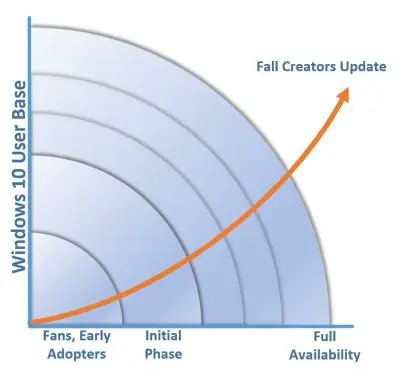Setting a new trend with the release of Windows 10 Creators Update earlier this year, Microsoft started following a targeted and phased rollout approach. This involved releasing the latest version only to a limited number of users at first. While the upgrade process was open to all Windows loyalists through media creation tool, the company refrained from sending the update unless the target device was thoroughly tested for the new edition.

Windows 10 v1709 Phased Rollout Approach
The change in the scheme of the rollout is an attempt to get focused feedback on application compatibility and how Windows works with the rich ecosystem of available peripherals like Bluetooth devices or cameras. The valuable input from these will invariably help Microsoft provide highest quality update experience for all its customers.
We closely monitor feedback from fans and early adopters, through programs like Windows Insiders and Windows Insider for Business, in addition to feedback from our OEM device partners, and customers like you! This helps us determine when to accelerate the release to additional devices, wrote John Cable / Director of Program Management, Windows Servicing, and Delivery in a blog post.
Our goal is to deliver feature updates to you as quickly as possible while providing you with the best possible update experience, he further added.
Some of the Windows 10 devices on which this feature update was tested in advance include, the most versatile laptop – new Surface Pro, Acer Swift 3, Acer Predator 15, ASUS ROG Zephyrus, Dell Inspiron 15 5000 Series 2-in-1, HP Pavilion x360 14, Lenovo Ideapad 320S and more.
Being on the latest version of Windows 10, the Windows 10 Fall Creators Update, provides the latest security protections to help keep you safer and brings latest features and capabilities. You can go for automatic update or choose to manually install Windows 10 Fall Creators Update.
Leave a Reply